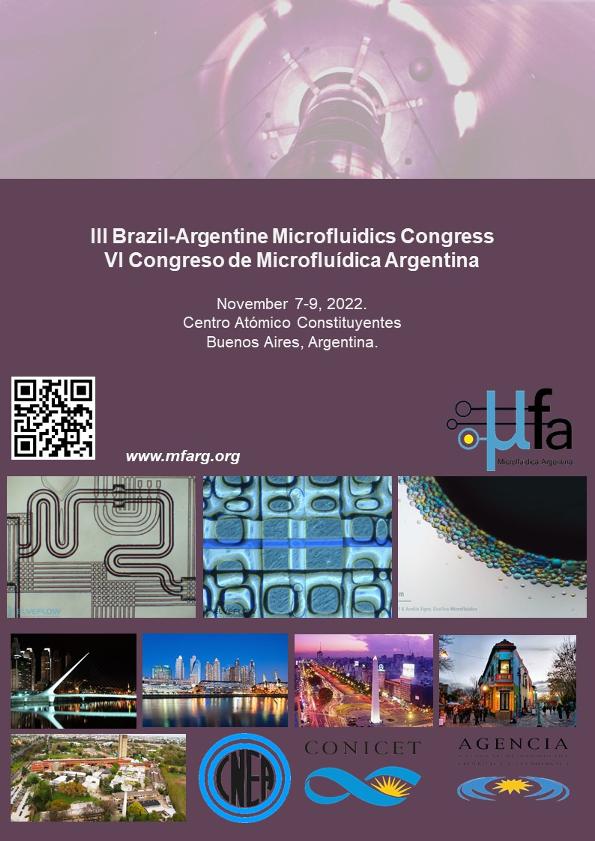Mostrar el registro sencillo del ítem
dc.contributor.author
Medina, Sabrina

dc.contributor.author
Padilla, María Florencia

dc.contributor.author
Avila, Adolfo María

dc.contributor.author
Madrid, Rossana Elena

dc.date.available
2024-02-08T14:03:20Z
dc.date.issued
2022
dc.identifier.citation
The effect of increasing ion capacity in the porous phase of a shock electrodialysis cell; III Brazil-Argentine Microfluidics Congress; VI Congreso de Microfluídica Argentina; Buenos Aires; Argentina; 2022; 64-65
dc.identifier.uri
http://hdl.handle.net/11336/226431
dc.description.abstract
Shock electrodialysis (SED) is an emerging electrokinetic purification method which is able to deionize solutions. This process only requires power for moving fluids through porous media, which avoid the need for high temperature (distillation) or high pressure (reverse osmosis, RO) systems. SED is essentially based on ion concentration polarization phenomenon. Concentration polarization is an interphase phenomenon which typically occurs when there is a mass transport limitation for the faster diffusing species in the fluid phase compared to the transport in the selective layer. Consequently, there is a reduction of the faster diffusing component in the boundary layer next to the selective layer and thus creating a depleted zone near the interphase. If a porous material is next to the interphase, now concentration polarization becomes higher due to the added diffusion limitation provided by the porous material and thus reducing even more the concentration of the faster diffusing species in the interphase. In our previous work, it was shown it is possible to extract a less concentrated electrolyte solution by continuous flow experiments in a miniaturized cell [1]. For this purpose, a biocarbon obtained through the pyrolysis of compressed residues from the sugarcane harvest was used as a porous phase to improve the polarization of the ion concentration. Through this system, the conductivity of a 0.1 mM KCl feed solution can be lowered by 25 percent over a period of 4 h working at a flow rate of 0.7 ccm and 5.0 V of applied voltage. This process was reversible by coming back to normal soon after the voltage was shut off. Different concentration ratios between the feed and the dilute phases can be obtained by changing the flow rate. This is an important advantage in terms of microfluidic device designs where operating flow rates are typically a few microliters. On the other hand, the separation performance between the feed and the more dilute outlet stream was improved by using a less permeable biochar material. In this work, the effect of increasing the ion capacity of the porous phase was studied by performing experiments through pulses of low concentration solutions (Fig. 1A). For this purpose, a zeolite material layer was included between two biochar disks. Fig. 1B shows the conductivity response when a pulse (1 cc) of low concentration solution (2 pS/cm) was injected into the feed. In the first injection, voltage was not applied. Voltage was switched on during the second injection. In this latter case, a significant depleted concentration stream at the cell outlet was observed. This is associated with the improved ion capacity of the porous phase due the presence of the zeolitic material.
dc.format
application/pdf
dc.language.iso
eng
dc.publisher
Comisión Nacional de Energía Atómica. Centro Atómico Constituyentes
dc.rights
info:eu-repo/semantics/openAccess
dc.rights.uri
https://creativecommons.org/licenses/by-nc-sa/2.5/ar/
dc.subject
Shock electrodialysis
dc.subject
Ion polarization
dc.subject
Electrolyte separation
dc.subject
Zeolite
dc.subject.classification
Otras Ingenierías y Tecnologías

dc.subject.classification
Otras Ingenierías y Tecnologías

dc.subject.classification
INGENIERÍAS Y TECNOLOGÍAS

dc.title
The effect of increasing ion capacity in the porous phase of a shock electrodialysis cell
dc.type
info:eu-repo/semantics/publishedVersion
dc.type
info:eu-repo/semantics/conferenceObject
dc.type
info:ar-repo/semantics/documento de conferencia
dc.date.updated
2024-02-02T15:12:17Z
dc.journal.pagination
64-65
dc.journal.pais
Argentina

dc.journal.ciudad
Buenos Aires
dc.description.fil
Fil: Medina, Sabrina. Consejo Nacional de Investigaciones Científicas y Técnicas. Centro Científico Tecnológico Conicet - Tucumán. Instituto de Química del Noroeste. Universidad Nacional de Tucumán. Facultad de Bioquímica, Química y Farmacia. Instituto de Química del Noroeste; Argentina
dc.description.fil
Fil: Padilla, María Florencia. Consejo Nacional de Investigaciones Científicas y Técnicas. Centro Científico Tecnológico Conicet - Tucumán. Instituto de Química del Noroeste. Universidad Nacional de Tucumán. Facultad de Bioquímica, Química y Farmacia. Instituto de Química del Noroeste; Argentina
dc.description.fil
Fil: Avila, Adolfo María. Consejo Nacional de Investigaciones Científicas y Técnicas. Centro Científico Tecnológico Conicet - Tucumán. Instituto de Química del Noroeste. Universidad Nacional de Tucumán. Facultad de Bioquímica, Química y Farmacia. Instituto de Química del Noroeste; Argentina
dc.description.fil
Fil: Madrid, Rossana Elena. Consejo Nacional de Investigaciones Científicas y Técnicas. Centro Científico Tecnológico Conicet - Tucumán. Instituto Superior de Investigaciones Biológicas. Universidad Nacional de Tucumán. Instituto Superior de Investigaciones Biológicas; Argentina
dc.relation.alternativeid
info:eu-repo/semantics/altIdentifier/url/https://sites.google.com/view/microfluidics2022/book-of-abstracts
dc.conicet.rol
Autor

dc.conicet.rol
Autor

dc.conicet.rol
Autor

dc.conicet.rol
Autor

dc.coverage
Internacional
dc.type.subtype
Congreso
dc.description.nombreEvento
III Brazil-Argentine Microfluidics Congress; VI Congreso de Microfluídica Argentina
dc.date.evento
2022-11-05
dc.description.ciudadEvento
Buenos Aires
dc.description.paisEvento
Argentina

dc.type.publicacion
Book
dc.description.institucionOrganizadora
Comisión Nacional de Energía Atómica. Centro Atómico Constituyentes
dc.source.libro
Book of Abstracts: III Brazil-Argentine Microfluidics Congress and VI Congreso de Microfluídica Argentina
dc.date.eventoHasta
2022-11-09
dc.type
Congreso
Archivos asociados
